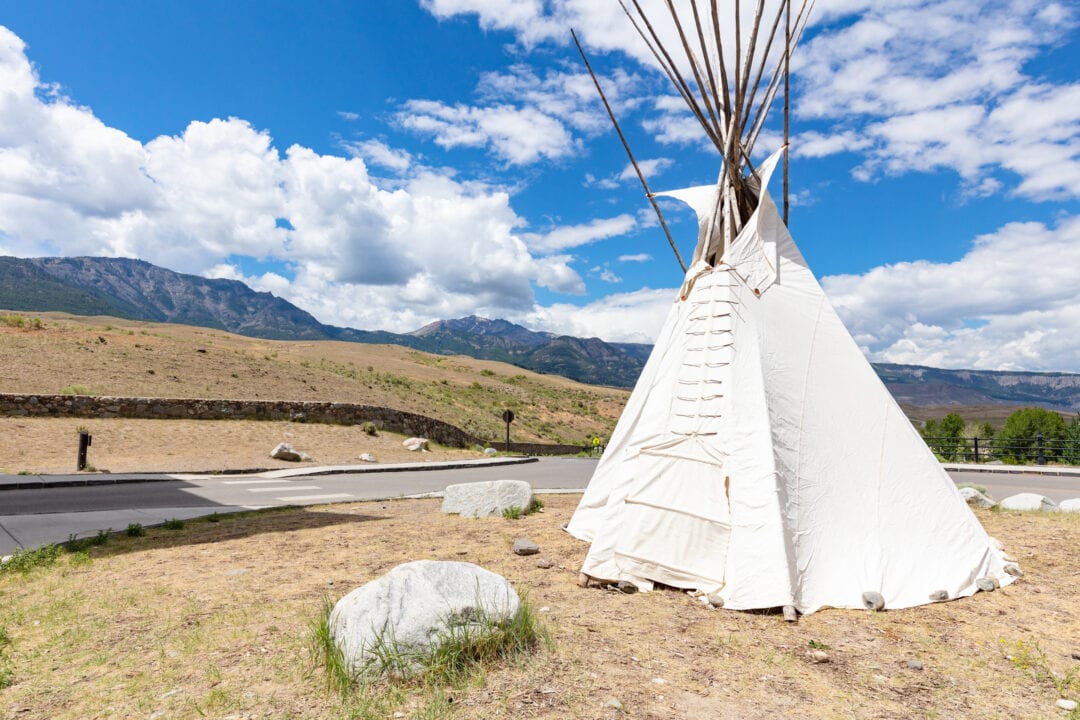On March 1, 1872, U.S. Congress and then-President Ulysses S. Grant designated Yellowstone as the nation’s first official national park. As the park celebrates its 150th anniversary in 2022, the National Park Service (NPS) is shining a light on the Native American tribes whose past, present, and future are an essential part of Yellowstone’s story.
Well before European Americans began exploring the region in the early 1800s, Native people lived in and traveled through the area, which today includes Wyoming, Montana, and Idaho. There is plentiful archeological evidence within the park, including Clovis points (a fluted projectile) from the Paleoindian Period (12,000 to 10,000 BCE) and traces of camps along the shores of Yellowstone Lake from the Archaic Period (8,000 to 1,000 BCE).

“So much of what most Americans call ‘wilderness,’ American Indians call ‘home,’” says Chuck Sams, an NPS director and enrolled member of the Confederated Tribes of the Umatilla Indian Reservation, in a statement. “Indigenous people served as the original stewards of these lands, understanding that the natural resources of land, water, air, flora, and fauna allowed humans not only to survive but to thrive.”
27 tribes
Historical evidence of early Native American habitation can sometimes overshadow another essential detail—that modern Tribal Nations are still very much a part of the story of Yellowstone: Twenty-seven tribes have historic and present-day connections to the land and resources of the park. As visitors from around the world make their way to Yellowstone to celebrate its 150th anniversary, the NPS wants to make sure that the voices of these Tribal Nations are front and center.
“This isn’t just about the last century and a half,” says Cam Sholly, superintendent of Yellowstone National Park. “We also want to use this anniversary to do a better job of fully recognizing many American Indian nations that lived in this area for thousands of years prior to Yellowstone becoming a park.”
According to the NPS, the Greater Yellowstone Ecosystem is one of the largest nearly intact natural ecosystems left in the world. Yellowstone National Park was created to preserve this region’s natural beauty, wildlife, unique geothermal and geological features, and cultural heritage.
“Our goal is to substantially engage every tribe connected to Yellowstone,” says Sholly. “It’s very important that the 150th anniversary is not just about Yellowstone as a national park but also a pivotal opportunity for us to listen to and work more closely with all associated tribes. […] The engagement we’re doing now will help set a stronger foundation for collaboration well into the future.”

Listening sessions and bison management
To date, that engagement has included working with several tribes on bison management, including transferring 28 bison to the Assiniboine and Sioux of the Fort Peck Indian Reservation in January 2002. Since 2019, the reservation has accepted the transfer of 182 bison that would have otherwise been culled as the park actively manages its herd.
The NPS has also hosted listening sessions with Yellowstone-associated tribes to help strengthen relationships and look toward the future. At one such event in June 2021, there was a temporary installation of a Crow-style teepee at the park’s North Entrance and a ceremony that included the story of the teepee’s origin and the singing of an honor song.
“As the park idea begins its next 150 years, we welcome new visitors, new perspectives, and new stories,” says Sams. “Fulfilling the promise of the park idea means our visitors will also learn and be moved by Selma and Stonewall, even as they are awed by Yellowstone and Yosemite.”
Anniversary celebrations
Interested in participating in the 150th-anniversary celebrations at Yellowstone National Park this summer? Check out these events that celebrate and discuss the past, present, and future of Tribal Nations in Yellowstone.
Tribal Heritage Center at Old Faithful
Visit the Tribal Heritage Center at Old Faithful from May through September, to see the work of Native American artists and scholars, and presentations for formal and informal learning opportunities throughout the summer.
Wind River Inter-Tribal Gathering
Join Tribal Nations, federal managers, and non-profit organizations June 1 to 3 to honor Native Americans while discussing conservation and collaborating on issues that are important to the tribes at the Wind River Inter-Tribal Gathering. The public is welcome, but registration is required.

Teepee Village
From July through August, a partnership of Tribal Nations will be establishing a teepee village near Roosevelt Arch at the North Entrance of Yellowstone National Park. At the village, Tribal members will be sharing stories and information about their cultures and heritage.
Nez Perce Appaloosa Horse Club Ride and Parade
Celebrate the history and culture of the Nez Perce during the Nez Perce Appaloosa Horse Club Ride & Parade, based at Yellowstone’s Canyon Village. During the event, members of the tribe will ride a section of the historic Nez Perce Trail, lead a horse parade in traditional regalia, and share stories of their ancestors.
For a complete list of 150th-anniversary events, visit 150 Years of Yellowstone.





